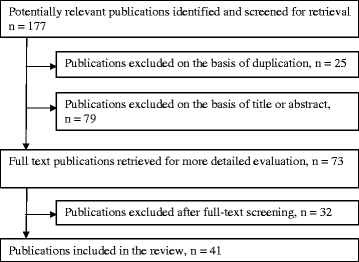Minimal important differences for fatigue patient reported outcome measures-a systematic review
- PMID: 27387456
- PMCID: PMC4937582
- DOI: 10.1186/s12874-016-0167-6
Minimal important differences for fatigue patient reported outcome measures-a systematic review
Abstract
Background: Fatigue is the most frequent symptom reported by patients with chronic illnesses. As a subjective experience, fatigue is commonly assessed with patient-reported outcome measures (PROMs). Currently, there are more than 40 generic and disease-specific PROMs for assessing fatigue in use today. The interpretation of changes in PROM scores may be enhanced by estimates of the so-called minimal important difference (MID). MIDs are not fixed attributes of PROMs but rather vary in relation to estimation method, clinical and demographic characteristics of the study group, etc. The purpose of this paper is to compile published MIDs for fatigue PROMs, spanning diagnostic/patient groups and estimation methods, and to provide information relevant for appraising their appropriateness for use in specific clinical trials and in monitoring fatigue in defined patient groups in routine clinical practice.
Methods: A systematic search of three databases (Scopus, CINAHL and Cochrane) for studies published between January 2000 to April 2015 using fatigue and variations of the term MID, e.g. MCID, MIC, etc. Two authors screened search hits and extracted data independently. Data regarding MIDs, anchors used and study designs were compiled in tables.
Results: Included studies (n = 41) reported 60 studies or substudies estimating MID for 28 fatigue scales, subscales or single item measures in a variety of diagnostic groups and study designs. All studies used anchor-based methods, 21/60 measures also included distribution-based methods and 17/60 used triangulation of methods. Both similarities and dissimilarities were seen within the MIDs.
Conclusions: Magnitudes of published MIDs for fatigue PROMs vary considerably. Information about the derivation of fatigue MIDs is needed to evaluate their applicability and suitability for use in clinical practice and research.
Keywords: Fatigue; MCID; MCII; MID; Minimal important difference; PROM; Systematic review.
Figures
References
-
- Winningham ML, Nail LM, Burke MB, Brophy L, Cimprich B, Jones LS, Pickard-Holley S, Rhodes V, St Pierre B, Beck S, et al. Fatigue and the cancer experience: the state of the knowledge. Oncol Nurs Forum. 1994;21(1):23–36. - PubMed
Publication types
MeSH terms
LinkOut - more resources
Full Text Sources
Other Literature Sources
Medical
Research Materials
Miscellaneous


